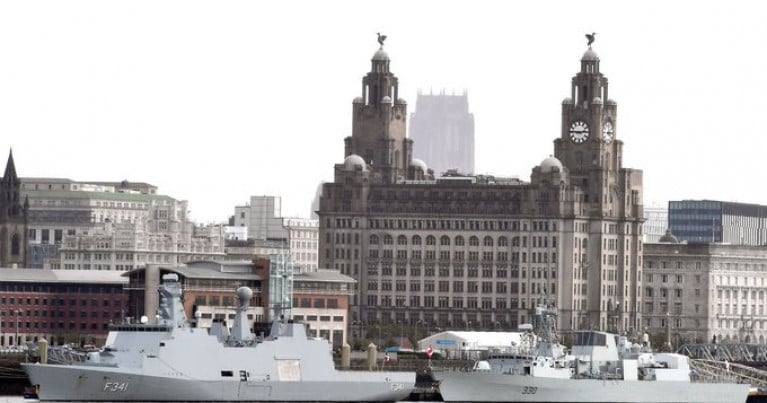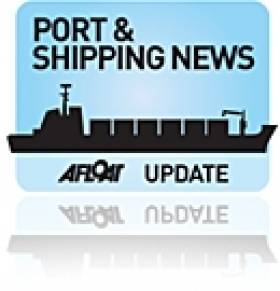Displaying items by tag: NATO
Royal Navy Blames Propeller Issues for Flagship’s Withdrawal From Historic NATO Drill
The UK’s Royal Navy has withdrawn its fleet flagship from a historic NATO exercise on Norway’s Arctic coast over what it says are issues with the vessel’s propeller.
According to Marine Industry News, the HMS Queen Elizabeth had been due to sail from Portsmouth on Sunday evening (4 February) until routine checks identified an issue with a coupling on the vessel’s starboard propeller shaft.
The £3.5bn, 65,000-ton aircraft carrier — which has parts constructed in the same shipyard that built the Naval Service’s LÉ George Bernard Shaw — will be replaced by sister ship HMS Prince of Wales in exercise Steadfast Defender 2024.
The Prince of Wales has had its own share of propeller issues, previously breaking down shortly after setting out for the United States on deployment in August 2022.
Steadfast Defender 2024 is NATO’s largest exercise since the end of the Cold War, involving some 90,000 military personnel from all NATO members and Sweden.
Marine Industry News has more on the story HERE.
NATO Warships Off North Wales Coast Anchor Ahead of 'Largest Military Exercise in Europe'
Two large naval warships which were spotted off North Wales this week, have berthed at the Port of Liverpool (Afloat adds, this morning they departed into the Irish Sea).
The Royal Canadian Navy's Royal Danish Navy's HDMS Absalon and HMCS Halifax arrived at the city's Cruise Liner Terminal on Thursday (yesterday).
Earlier this week, they were spotted off the coast of North Wales.
Officials then remained tight-lipped about why they were in the area, but it is understood that they are taking part in a major two-week exercise off Scotland later this month.
Joint Warrior takes place in the spring and autumn each year, reports the Liverpool Echo.
More on this naval flotilla from NorthWalesLive here.
NATO Minehunters To Make Bold Display In Belfast Lough
#BelfastLough - A fleet of eight NATO minehunters is set to make a bold display in Belfast Lough tomorrow morning (Friday 17 October).
As the Ballymena Times reports, the ships and their international crews - part of the Standing NATO Mine Counter-Measures Group - will be in Belfast till next Tuesday as part of an exercise led by the Royal Navy.
Though they won't be open to the general public, it's still a great opportunity to see so many military vessels in one setting.
VOR Second Leg Cut Short Over Piracy Concerns
#VOLVO OCEAN RACE - The second leg of the Volvo Ocean Race from Cape Town to Dubai has been cut short by organisers as a result of the growing threat of piracy in the Indian Ocean, The Irish Times reports.
The six yachts competing will be protected by armed guards as they are shipped on a secret route to the United Arab Emirates due to piracy concerns.
The boats will be transported by ship from an undisclosed location to Sharjah in the Arabian Gulf, from where they will sprint to the finish line in Abu Dhabi.
All six teams are currently in Cape Town, with Team Sanya, PUMA and Abu Dhabi Ocean Racing hoping to get back in the race after retiring in the first leg.
As previously reported on Afloat.ie, NATO recently foiled a pirate attack on a Spanish fishing vessel between the Seychelles and the Somali coast.
The Irish Times has more on the story HERE.
Indian Ocean Pirates Ready to Attack
MC Northwood's Chief of Staff, Rear Admiral Hank Ort (NLD N) states, "in the last few years, it has been the case that come October when the South West monsoon weakens, the pirates have been able to put to sea and we have seen the number of attacks on merchant vessels increase. We are warning vessels that reports show that there are pirate groups operating already in the Indian Ocean, Arabian Sea and Gulf of Aden. Merchant vessels should ensure that Best Management Practices are followed and that vessels continue to make it as difficult as possible for pirates to board and take control of their ships. Our Naval forces are not complacent and remain vigilant. Despite the lull in pirate attacks over the summer due to the monsoon they have continued to patrol throughout the region."
New NATO Website to Combat Piracy Goes Live
Having received a briefing on the new website, the Commander of MC Northwood, Admiral Sir Trevor Soar KCB OBE said;
"Piracy is a serious threat for the shipping community and anything that can be done to deal with and overcome this issue is to be welcomed. The NATO Shipping Centre has listened to their users and responded to their needs with a new, more interactive and relevant website demonstrating that NATO and the shipping community are working together to tackle the scourge of piracy."
NATO Issue Guidelines to Prevent Piracy
The products tanker Ardmore Seafarer (2004 / 45,744 dwt ) which was at sea 1,000 (nm) nautical miles off Somalia and some 500 nm off the coast of India, came under the attack of pirates last year.
The 179m long vessel which is operated by the Cork based Ardmore Shipping Group managed to evade the attack and potential seizure of the vessel thanks to the decisive action of the ships master, Captain Benamu. For more information about the Irish based company here and for a picture of the vessel click this link.
Though, the fate to other commercial shipping, was less fortunate, when 23 vessels were attacked in the Arabian Sea alone, in January of this year. Five of those attacks have resulted in the ships being taken over and held by the pirates.
To combat this threat, NATO, the EU Naval Force (EUNAVFOR) and Coalition Maritime Force (CMF), together with warships from other nations, continue to operate in attempting to prevent pirate hijacks. Though not every vessel can be guaranteed a warship to intervene from the threat of pirates, due to the sheer size of the sea area, which is the equivalent to an area the size of western Europe.
On an annual basis, there are approximately 22,000 ship movements that transit the Gulf of Aden and many of these now use Best Management Practices (BMP).
Some of the guidelines set by the BMP is for a vessel to set a high speed through the area, the placing of barbed wire around the ship and the use of water cannons to ward off an imminent attack. Ships with a low freeboard and at a slow speed, and small vessels, such as yachts, are particularly vulnerable to pirate attack.
Since December 2008, NATO has contributed to the international counter piracy effort off the Horn of Africa. This requires protecting the ships providing UN and World Food Programme through Operation Allied Provider and in general merchant shipping traffic plying in the Gulf of Aden.
In addition to these activities, Operation Ocean Shield, NATO is working with other international bodies to help develop capacity of countries in the region to tackle piracy on their own.
Under the Standing NATO Maritime Group 2 which is permanently assigned to NATO. This is a multi-national naval group formed through the NATO Alliance that provides a stand-alone task force with the ability to quickly respond to crisis situations anywhere in the world.
The current commander of NATO Maritime Group 2 is Commodore Michiel B. Hijmans of the Royal Netherlands Navy. The fleet consists of the Dutch HNLMS De Ruyter (the 'flagship' of the international fleet), HDMS Esbern Snare (Denmark), USS Bainbridge and USS Laboon (USA) and TCG Giresun from the Turkish Navy.
NATO is to continue operating their counter-piracy measures by extending Operation Ocean Shield to December 2012. To read more about the pirate attacks, the Best Management Practices and general advice for vessels logon to the NATO Shipping Centre www.shipping.nato.int
Royal Navy Anti-Piracy Frigate Visits Dublin Port
The Royal Navy's Type 22 frigate HMS Chatham (F87) which recently returned to UK waters after a seven month deployment on anti-piracy duties off Somalia, visited Dublin Port last weekend, writes Jehan Ashmore.
HMS Chatham was the lead vessel for NATO's 'Operation Ocean Shield' as part of a multi-national task force in the seas off the African state that in recent years has become notorious for piracy.

HMS Chatham departs Dublin Bay and the rocks off Dalkey Island. Photo: Jehan Ashmore /ShipSNAPS
The frigate departed Dublin on Monday afternoon and set an easterly course off the Baily Lighthouse, but surprisingly the 5,300 tonnes vessel returned into the bay. HMS Chatham then crossed the bay towards Sandycove. From there the 148m vessel which has a draft of 6.7m veered in a south-easterly direction, to sweep past off the rocky outcrop, to the north of Dalkey Island and continued southbound off The Muglins.
In mid-November the frigate visited her namesake port on the Medway to mark the 20th anniversary since the vessel's commissioning at Chatham in 1990. The occasion was also the first time that such an event had taken place outside a Royal Navy establishment.
Built in 1988, the vessel was launched from the Swan Hunter shipyard on the Tyne and is normally based in her homeport of Devonport, Plymouth.
Pirate Attack Group Destroyed by NATO Warships
The NATO warships, HMS CHATHAM and USS COLE destroyed a group of 3 pirate vessels over the weekend in the Somali Basin. Two of the boats were destroyed and a third confiscated.
A Swedish Maritime Patrol Aircraft (MPA), part of the EU NAVFOR and operating out of the Seychelles located 3 skiffs on Friday 23 April; one large whaler type and 2 smaller “attack” skiffs. HMS CHATHAM was quickly dispatched to the scene and after 5 hours spotted boats which were approximately 500 miles from the Somali coast. On the warship’s arrival, the 2 smaller skiffs approached, as if they intended to attack. However, once closer, they started manoeuvring at high speed in an attempt to evade HMS CHATHAM, before fleeing in different directions. The larger boat was pursued until it was brought to a stop and the pirates surrendered. The ship’s Royal Marines (RM) detachment boarded this craft to find 4 pirates on board and a large amount of fuel.
Whilst this was happening, one of the smaller skiffs, with a further 5 pirates on board, returned to the area and surrendered to the RM team. A search of these boats revealed that the pirates had disposed of their weapons and other equipment during the pursuit. As darkness fell the third skiff remained un-located.
The following day the pirates and the “attack” skiff were brought on board HMS CHATHAM and the whaler was destroyed by gunfire from the Ship’s 20mm guns. On Sunday 25 Apr, the MPA spotted the third skiff now dead in the water and USS Cole, which was in the area, quickly found and boarded the craft. This skiff was destroyed by the US warship and the 4 pirates transferred to HMS CHATHAM.
With the pirate gang well and truly out of action, the pirates were landed to the Somali coast with all 3 of their pirate vessels and equipment confiscated, destroyed or abandoned.
The Commanding Officer of HMS CHATHAM, Commander Simon Huntington said
“This has been a truly international effort in the fight against piracy in the region. Working closely together, HMS CHATHAM, USS COLE and the EU NAVFOR Swedish coastguard aircraft ‘Bluebird’ have successfully located and destroyed this pirate attack group. Once again NATO warships and our international partners have taken direct action which has prevented another pirate group from attacking merchant shipping in the area.”
At sea NATO is working closely with other partners including EU Naval Force, Combined Maritime Force as well as other navies, including China, Japan, India and Russia.



































































